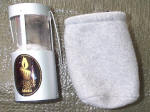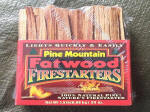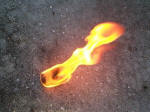|

A candle lantern with its protective bag. The lantern is in its extended
position. I use a lantern so the flame is enclosed when I am in the
"squat" position for initial hypothermia recovery. (See the surviving
article.)
The candle lantern is essential for adding heat to your body/poncho tipi during
the initial recovery phase.
|

You need some kindling. Fatwood can be purchased in grocery stores.
This wood is very dry and contains resin so it burns easily and hot enough to
start your other kindling. Indians and other long distance explorers
carried their own kindling to insure dry wood for fire starting. They
knew they didn't have any backup. Neither do you.
|

But you don't need a whole box. Select 6 or so of the best pieces and put
them in a Ziploc bag. You might need to cut them to length
too.
If you make your own kindling bundle, be sure to put the sticks in their own
Ziploc bag. These pieces of wood have lots of resin and can contaminate
other items. Also, my paranoid nature says if the purpose is to have dry
kindling, then by God another layer of protection is just what we need.
|
|

You can use commercial fire paste or ribbon. The matches should be BOTH
wind and waterproof.
|

Or you can make your own fire starters by using cotton balls and Vaseline.
Work the Vaseline into the cotton balls and place the goo into a 35 mm film
can. You can easily fit 8-10 "fuel balls" into one canister. Use
plenty of Vaseline.
|

Just pull one out and sort of spread it apart by pulling at it. Touch a
match to it and it ignites immediately. Careful, these babies light up
quick.
It burns for maybe one or two minutes. Your dry Fatwood and other kindling
should be ready before your light it up.
Preparation of your fire is key.
|
|

The hypothermia kit laid out on top of its nylon pack:
-
Modified space blanket
-
Candle lantern
-
Commercial kindling pack (fatwood) including hurricane matches
-
Fire starters in 35mm canister
-
Box of hurricane matches.
-
Box of regular waterproof matches.
The picture shows a Mylar/aluminum sleeping bag, but that small item put my kit
over the top. Although it fit in the hypothermia nylon pack, it added
just enough volume to over fill the EFT Pack so I took it out. Nice item
though if you have room.
|

The nylon pack folded, zipped up, and placed inside a Ziploc bag.
This bag gets stuffed into the backpack attached to my PFD.
Why so many Ziplocs? Well, I'm paranoid about getting my emergency fire
stuff wet. Also, the Ziplocs turn this package into flotation.
Everything that goes into my PFD backpack contributes to additional flotation.
Note that the Ziplocs I use are the freezer bag type because they are more
durable. You can also try Aloksak bags available from
Brigade Quartermasters for the ultimate security. Probably a
combination of the two types would be optimum.
|
The emergency survival sleeping bag is
84" x 36" and needs no modification. Its relatively low bulk and weight
are attractive, but it belongs in your second layer of defense, the emergency
shelter kit, rather than your hypothermia kit. The sleeping bag is also a
Stansport product.
The kit contains both hurricane matches and regular waterproof matches. I
use one or the other depending on the situation. Hurricane matches are
hard to put out and must burn out. I only use them if the situation
warrants it due to the wind or shivering.
This kit contains everything you need to build a fire, but don't use it on a
daily basis. You should have your regular fire making supplies in your
regular kit. Only use this kit in actual practice sessions which
you should do at least once a season. Be sure to inspect and replace as
needed.
|